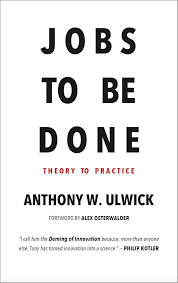Unlocking Customer Needs: A Comprehensive White Paper on the "Jobs to Be Done" Framework
Introduction
In today's dynamic marketplace, understanding customer needs transcends traditional market research methodologies. Demographics and stated preferences often provide a superficial understanding, failing to capture the deeper motivations that drive customer behavior. The "Jobs to Be Done" (JTBD) framework, pioneered by Clayton Christensen and further developed by Anthony Ulwick, offers a powerful alternative by shifting focus from who the customer is to what they are trying to achieve. This white paper delves into the core principles, applications, and use cases of JTBD, demonstrating its transformative potential for businesses seeking to innovate and thrive.
1. The Core Principles of JTBD
At its core, JTBD posits that customers "hire" products and services to fulfill specific needs or "jobs" in their lives. These "jobs" are not merely tasks but encompass the progress customers seek to make in a particular circumstance. Ulwick's Outcome-Driven Innovation (ODI) methodology provides a structured framework for applying JTBD, emphasizing the identification and prioritization of customer desired outcomes.
Key Principles:
- Focus on the "Job": JTBD emphasizes understanding the underlying need or "job" a customer is trying to accomplish. This goes beyond identifying product features to understanding the customer's desired state and the progress they seek to make. For example, a customer might "hire" a smartphone not just to make calls, but to "stay connected with loved ones," "express their individuality," or "feel a sense of belonging."[1]
- Circumstances Matter: The context in which a customer "hires" a product or service significantly influences their needs and desired outcomes. The same product can be "hired" for different "jobs" depending on the situation. A cup of coffee, for instance, might be "hired" to "wake up in the morning," "enjoy a social break," or "find solace in the evening."
- Desired Outcomes: JTBD prioritizes understanding the specific outcomes customers seek when "hiring" a product or service. These outcomes can be functional, emotional, or social. For example, for the "job" of "commuting to work," desired outcomes might include: "arrive at work on time," "reduce stress during the commute," "have time for personal activities during the commute."[2]
2. Applications of JTBD
The JTBD framework offers a versatile approach applicable across various business functions:
- Innovation: By understanding the "jobs" customers are struggling to get done, businesses can identify unmet needs and develop innovative solutions that address them effectively. This leads to products and services that resonate with customers and have a higher chance of success.
- Product Development: JTBD helps define product requirements based on customer desired outcomes. This ensures that development efforts are focused on features and functionalities that truly matter to the customer, minimizing the risk of building the wrong product.
- Marketing and Sales: JTBD provides insights into customer motivations and pain points, enabling marketers to craft compelling messages that resonate with target audiences. Sales teams can leverage JTBD to understand customer needs better and position products as solutions to their specific "jobs."
- Customer Experience: JTBD helps organizations design customer journeys that are aligned with customer needs and desired outcomes. This leads to improved customer satisfaction, loyalty, and advocacy.
3. Use Cases of JTBD
- Case Study 1: Airbnb
- "Job": "Find and book unique and authentic travel experiences."
- JTBD Application: Airbnb focused on understanding the desires of travelers seeking more than just a place to stay. They identified the "job" of experiencing authentic travel and developed a platform that connects travelers with unique accommodations and local experiences, fostering a sense of community and cultural immersion.
- Case Study 2: Netflix
- "Job": "Easily access and enjoy high-quality entertainment at any time."
- JTBD Application: Netflix recognized the "job" of convenient and personalized entertainment consumption. They developed a streaming platform that offers a vast library of movies and TV shows, personalized recommendations, and on-demand access, effectively addressing the evolving needs of viewers.
- Case Study 3: Tesla
- "Job": "Own and experience a sustainable and technologically advanced vehicle."
- JTBD Application: Tesla focused on the "job" of owning a car that is not only a mode of transportation but also a symbol of environmental consciousness and technological innovation. They developed electric vehicles with cutting-edge technology, a focus on sustainability, and a unique brand experience that resonates with customers seeking to make a statement.
4. Benefits of JTBD
Adopting the JTBD framework can lead to several significant benefits:
- Reduced Risk of Innovation Failure: By focusing on unmet customer needs, JTBD increases the likelihood of developing successful products and services that customers truly want.
- Improved Customer Satisfaction: Understanding and addressing customer desired outcomes leads to enhanced customer experiences and increased satisfaction.
- Increased Market Share: Products and services that effectively address customer "jobs" are more likely to gain market share and outperform competitors.
- Enhanced Profitability: Successful innovation driven by JTBD can lead to increased revenue and profitability.
Conclusion
The "Jobs to Be Done" framework offers a powerful lens for understanding customer needs and driving innovation. By focusing on the "jobs" customers are trying to get done and their desired outcomes, businesses can develop solutions that truly resonate and achieve market success. Ulwick's Outcome-Driven Innovation methodology provides a structured approach to applying JTBD, enabling organizations to measure and prioritize customer needs, leading to more effective innovation, product development, marketing, and customer experience strategies.
References
- Christensen, C. M., Anthony, S. D., Berstell, G., & Nitterhouse, D. (2007). Finding the right job for your product. MIT Sloan Management Review, 48(3), 38.1
Note: This white paper provides a comprehensive overview of the JTBD framework. For a deeper dive into specific use cases and real-world applications, further research and case studies are recommended.



